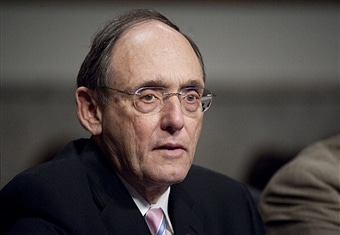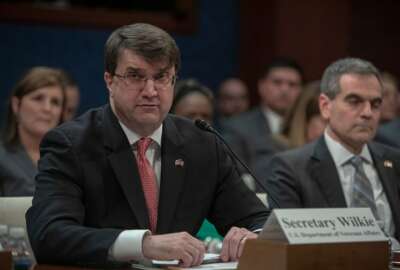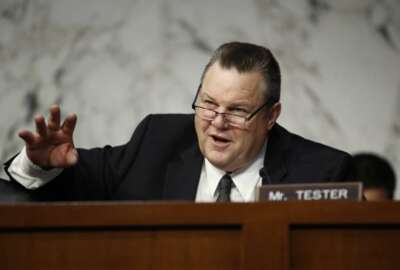

As Congress piles on new initiatives for the Department of Veterans Affairs to implement, the agency is struggling to keep up with the IT updates that those new or...
Best listening experience is on Chrome, Firefox or Safari. Subscribe to Federal Drive’s daily audio interviews on Apple Podcasts or PodcastOne.
IT upgrades are key to several new initiatives at the Department of Veterans Affairs, and the agency is struggling to ensure those updates don’t delay or burden new programs that are supposed to go live in the coming months.
And the recent, high-profile delays associated with VA’s implementation of the Forever GI bill, for example, are adding additional pressure.
The department’s inspector general recently found VA was doomed from the start when it set out to implement the new GI bill, which Congress passed into law back in 2017. VA had estimated it would need either an additional $70 million or 1,000 more employees to make the updates needed to comply with the new GI bill by the initial deadline, according to the IG’s report.
But VA didn’t make those upgrades on time, and it announced back in November it would delay distributing education benefits under the new law until the end of 2019.
The department didn’t exude confidence Tuesday when it discussed the IT upgrades associated with two other major initiatives, and at least a few members on the Senate Veterans Affairs Committee expressed some concern with the progress.
To implement the VA MISSION Act, the department is supposed to develop a decision support tool, which will help providers determine whether their patients meet the agency’s new criteria to see a doctor in the community.
It’s unclear if that system will be ready by the June 6 kick-off deadline, but VA said veterans wouldn’t notice the difference. VA currently authorizes 300,000 agency appointments and 50,000 community care visits on a given day, said Richard Stone, VA’s acting undersecretary for health.
“That is all done on a manual basis by our providers and schedulers,” he said. “On June 6, it is our hope to have something called a decision support tool that will automate that process. Should we fail with the decision support tool, it will look just exactly like it does today. There will be an enhanced number of veterans eligible to make a decision of whether they want to go out for care or not. But the system will look very similar to the system today.”
The status of IT updates for recently expanded caregivers program is also in question. VA is supposed to certify that a new commercial, off-the-shelf system designed to automate payments to caregivers is ready by Oct. 1.
Today, VA manually processes and writes checks to 24,000 beneficiaries of the department’s existing caregivers program. But when the program expands this fall to include caregivers all war eras, that manual process will only become more difficult to manage.
“As we move to this commercial, off-the-shelf software system, what we will need is to migrate all of the data over and then assure that we can, on an automated basis, write the checks every month before we’re ready to expand,” Stone said. “Although we’ve made a decision on the software system, [for] the migration of that data we have not recommended a certification date yet on the software system and expansion.”
VA didn’t say directly whether it would meet the Oct. 1 deadline when asked.
“I’m not going to do it unless it’s right,” VA Secretary Robert Wilkie added.
Beyond the IT upgrades needed to finish implementing the Forever GI bill and both the consolidated community care and expanded caregivers programs under the MISSION Act, VA is also juggling the behemoth move to modernize and adopt a new electronic health record that’s interoperable with the Pentagon.
Stone said the department plans to begin rolling out the new EHR to a few sites in the Pacific Northwest next March. Achieving initial operating capability is on schedule, but VA has encountered additional work it needs to do to prepare.
“These are old facilities,” Stone said. “We need to rebuild our communication closets, and that’s going to go on this summer. We also need to work our way through all of the internet-[connected] devices.”
The department on Tuesday also fielded the usual concerns from Senate Democrats about the path VA planned to take in implementing the MISSION Act and consolidating its seven existing community care program into one.
“I heard, without exception at our hearings with the [veterans service organizations], we’re not going to privatize said 100 times,” VA committee Chairman Johnny Isakson (R-Ga.) said. “I didn’t have a single person write me, call me, trip me up and throw me down the steps or anything else that wanted to privatize the VA.”




“Everything that I’m hearing and everything that I’m seeing says something different,” Tester said.
Members on the Senate VA Committee on both sides of the aisle described situations where vacancies were prevalent at medical facilities in their districts.
“This morning there were 138 positions posted on USAJOBS[.gov] in my state,” Sen. Joe Manchin (D-W.V.) said. “I have pulmonologists [and] cardiologists in Huntington, psychology in Beckley, practitioners in Martinsburg. We’re hurting all over the board. Even though the intent might not be there, it looks like the signs are moving in that direction because of demand from our veterans. If our veterans are getting care, they’re going to say, ‘I just need better care. I’m not getting it, and the facility is not worth even going to because it’s not in good enough shape.’ You can see the concern, Mr. Secretary, of what we have and what we have to answer to.”
VA has nearly 45,000 vacancies, according to the most recent public data from the department.
Wilkie said new relocation bonuses, student loan repayment and the other incentives Congress recently authorized in the MISSION Act are a helpful tool in filling some of those vacancies.
He also described the possibility of creating a “veterans Peace Corps,” which would place medical professional at VA hospitals in rural areas. In addition, Wilkie described an idea that Gen. Omar Bradley once described when he led the department during the Truman administration.
“General Bradley’s goal was to have at least the doctors and nurses coming off active duty coming into VA,” Wilkie said. “General Mattis spoke a great deal about that. We are now telling doctors that when they decide to leave active service, [they] should come to VA to continue [their] service to those who have worn the uniform. I want to go back to the future on that.”
VA told Congress it needed an additional $60 billion for major and minor construction projects at its facilities. The department’s 2020 budget request, however, cuts major construction funding by more than 40 percent and minor construction spending by nearly 50 percent.
“Putting all that together, how can we justify that?” Tester said.
The department said it received construction spending boosts back in 2018 and 2019, and some of those leftover funds would go toward projects in 2020.
The VA MISSION Act also authorized the department to stand up an Asset and Infrastructure Review committee, which is supposed to examine the department’s existing facilities, and study and forecast the veterans population in individual markets across the country.
According to the new law, the committee isn’t supposed to begin those facility reviews until 2022, but Wilkie said the demand for upgrades and maintenance at VA medical centers may prompt him to ask that those reviews begin sooner.
Copyright © 2024 Federal News Network. All rights reserved. This website is not intended for users located within the European Economic Area.
Nicole Ogrysko is a reporter for Federal News Network focusing on the federal workforce and federal pay and benefits.
Follow @nogryskoWFED
